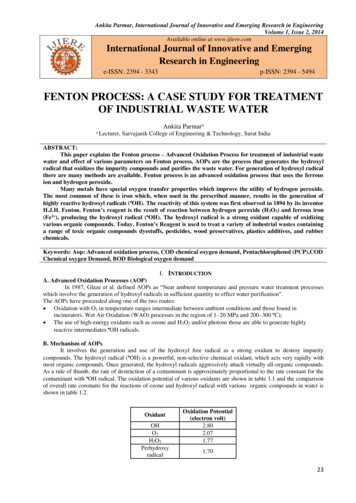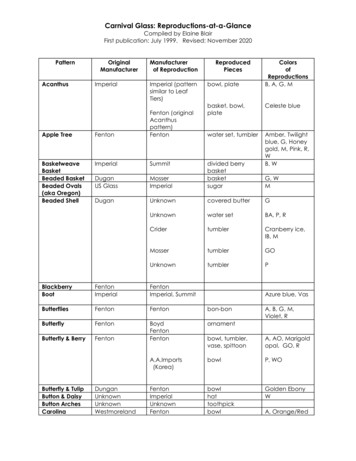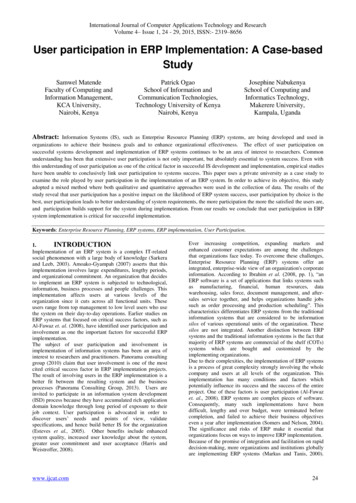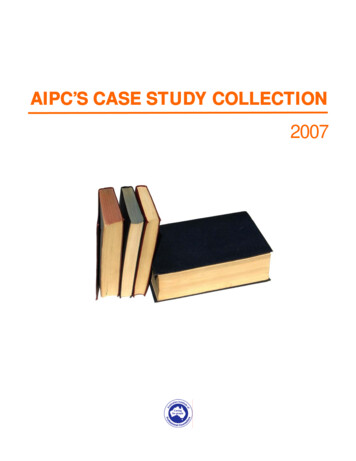
Transcription
Ankita Parmar, International Journal of Innovative and Emerging Research in EngineeringVolume 1, Issue 2, 2014Available online at www.ijiere.comInternational Journal of Innovative and EmergingResearch in Engineeringe-ISSN: 2394 - 3343p-ISSN: 2394 - 5494FENTON PROCESS: A CASE STUDY FOR TREATMENTOF INDUSTRIAL WASTE WATERAnkita ParmaraaLecturer, Sarvajanik College of Engineering & Technology, Surat IndiaABSTRACT:This paper explains the Fenton process – Advanced Oxidation Process for treatment of industrial wastewater and effect of various parameters on Fenton process. AOPs are the process that generates the hydroxylradical that oxidizes the impurity compounds and purifies the waste water. For generation of hydroxyl radicalthere are many methods are available. Fenton process is an advanced oxidation process that uses the ferrousion and hydrogen peroxide.Many metals have special oxygen transfer properties which improve the utility of hydrogen peroxide.The most common of these is iron which, when used in the prescribed manner, results in the generation ofhighly reactive hydroxyl radicals ( OH). The reactivity of this system was first observed in 1894 by its inventorH.J.H. Fenton. Fenton’s reagent is the result of reaction between hydrogen peroxide (H 2O2) and ferrous iron(Fe2 ), producing the hydroxyl radical ( OH). The hydroxyl radical is a strong oxidant capable of oxidizingvarious organic compounds. Today, Fenton’s Reagent is used to treat a variety of industrial wastes containinga range of toxic organic compounds dyestuffs, pesticides, wood preservatives, plastics additives, and rubberchemicals.Keywords: Aop: Advanced oxidation process, COD chemical oxygen demand, Pentachlorophenol (PCP),CODChemical oxygen Demand, BOD Biological oxygen demandI. INTRODUCTIONA. Advanced Oxidation Processes (AOP)In 1987, Glaze et al. defined AOPs as “Near ambient temperature and pressure water treatment processeswhich involve the generation of hydroxyl radicals in sufficient quantity to effect water purification”.The AOPs have proceeded along one of the two routes: Oxidation with O2 in temperature ranges intermediate between ambient conditions and those found inincinerators. Wet Air Oxidation (WAO) processes in the region of 1–20 MPa and 200–300 ºC); The use of high-energy oxidants such as ozone and H2O2 and/or photons those are able to generate highlyreactive intermediates OH radicals.B. Mechanism of AOPsIt involves the generation and use of the hydroxyl free radical as a strong oxidant to destroy impuritycompounds. The hydroxyl radical ( OH) is a powerful, non-selective chemical oxidant, which acts very rapidly withmost organic compounds. Once generated, the hydroxyl radicals aggressively attack virtually all-organic compounds.As a rule of thumb, the rate of destruction of a contaminant is approximately proportional to the rate constant for thecontaminant with OH radical. The oxidation potential of various oxidants are shown in table 1.1 and the comparisonof overall rate constants for the reactions of ozone and hydroxyl radical with various organic compounds in water isshown in table 1.2.OxidantOHO3H2O2PerhydroxyradicalOxidation Potential(electron volt)2.802.071.771.7023
Ankita Parmar, International Journal of Innovative and Emerging Research in EngineeringVolume 1, Issue 2, 2014Permanganate1.67ionChlorine dioxide1.50Chlorine1.36Oxygen (O2)1.23Table 1.1 Oxidation Potential of Several Oxidants in WaterCompound TypeAromaticsKetonesNitrogencontaining organicsPhenolsSulfur containingorganicsOverall Rate Constant(liter per mole second) O31 to 102OH10 to 10101109 to 101010 to 102108 to 101010310 to 1.6 x103109 to 10108109 to 1010Table 1.2 Overall Rate Constants for O3, and OH Reactions with Organic Compounds in Water1.3 Methods to Produce Hydroxyl Radicals ( OH)Several methods are available for generating OH radicals. These are ozone based as well as non-ozone basedprocesses. These include both non-photochemical and photochemical essesOzone basedprocessesOzonationat elevated pH ( 8.5)Ozone hydrogenperoxide(O3/H2O2)Ozone catalyst(O3/CAT)O3/UVO3/H2O2/UVNon Ozone basedprocessesFentonsystem(H2O2/Fe2 )H2O2/UVPhoto-Fenton(H2O2/Fe2 /UV)Fenton-like systems(H2O2/Fe3 /UV)Photo-catalytic oxidation(UV/TiO2)Table 1.3 Methods to Produce Hydroxyl RadicalsII. FENTON PROCESS (H2O2/FE2 )A. Fenton’s reagentMany metals have special oxygen transfer properties which improve the utility of hydrogen peroxide. Themost common of these is iron which, when used in the prescribed manner, results in the generation of highly reactivehydroxyl radicals ( OH). The reactivity of this system was first observed in 1894 by its inventor H.J.H. Fenton, but itsutility was not recognized until the 1930’s once the mechanisms were identified.Fenton’s reagent is the result of reaction between hydrogen peroxide (H2O2) and ferrous iron (Fe2 ), producingthe hydroxyl radical ( OH). The hydroxyl radical is a strong oxidant capable of oxidizing various organic compounds.Today, Fenton’s Reagent is used to treat a variety of industrial wastes containing a range of toxic organiccompounds (phenols, formaldehyde, BTEX, and complex wastes derived from dyestuffs, pesticides, woodpreservatives, plastics additives, and rubber chemicals).24
Ankita Parmar, International Journal of Innovative and Emerging Research in EngineeringVolume 1, Issue 2, 2014B. Chemistry of Fenton ProcessThe rate constant for the reaction of ferrous ion with hydrogen peroxide is high and Fe2 oxidizes to Fe3 in afew seconds to minute in the presence of excess amounts of hydrogen peroxide.Fe 2 H2O2 Fe3 OH OHHydrogen peroxide decomposes catalytically by Fe3 and generates again hydroxyl radicals according tofollowing reactions:Fe3 H2O2 H Fe – OOH2 2 Fe – OOH HO2 Fe 2 2 Fe H2O2 Fe3 OH OHFor this reason, it is believed that most waste destruction catalyzed by Fenton’s reagent is simply aFe3 –H2O2 system catalyzed destruction process, and Fenton’s reagent with an excess of hydrogen peroxide isessentially a Fe3 –H2O2 process (known as a Fenton-like reagent). Thus, the ferrous ion in Fenton’s reagent can bereplaced with the ferric ion. Iron salts act as a catalyst for hydrogen peroxide decomposition, further reactionsregenerate iron Fe2 . It has been demonstrated by various researchers that: Fenton’s reagent is able to destroy different phenols, nitrobenzene, and herbicides in water media as well asto reduce COD in municipal wastewater. The Fe2 /H2O2 system acts as a potential oxidant for soil contaminants can also been investigated. Pentachlorophenol (PCP) and trifluralin are extensively degraded while hexadecane and dieldrin canpartially transformed in a soil suspension at acidic pH. The use of Fe2 /H2O2 as an oxidant for wastewater treatment is attractive due to:(1) Iron is a highly abundant and non-toxic element,(2) H2O2 is easy to handle and environmental friendly substance.Thus, the Fenton process is very effective for OH Hydroxyl radicals generation; however, it involvesconsumption of one molecule of Fe2 for each OH radical produced, demanding a high concentration of Fe 2 .C. Oxidation of impurity molecules by Hydroxyl radical ( OH)Depending upon the nature of the organic impurity, following types of reactions are possible:1. By radical addition: The addition of the hydroxyl radical to an unsaturated aliphatic or aromatic organiccompound (e.g.,C6H6) results in the production of a radical organic compound that can be oxidized further. Itcan add itself to the contaminant, as in the case of olefins or aromatic compounds.R OH ROH2. By hydrogen abstraction: The hydroxyl radical can abstract a hydrogen atom from water, as with alkanes oralcohols, The removal of a hydrogen atom results in the formation of a radical organic compound, initiating achain reaction where the radical organic compound reacts with oxygen, producing a peroxyl radical, which canreact with another compound and so on.R OH R H2O3. By electron transfer: Electron transfer results in the formation of ions of a higher valence. Oxidation of amonovalent negative ion will result in the formation of an atom or a free radical.R n OH R n-1 OH 4. By radical combination: Two radicals can combine to form a stable product. See reaction. OH OH H 2O 2Figure 2.1 Flow diagram for Industrial waste water treatmentFantonProcessFigure 2.1 Flow diagrams for Industrial waste water treatment25
Ankita Parmar, International Journal of Innovative and Emerging Research in EngineeringVolume 1, Issue 2, 2014III PARAMETERS THAT AFFECTS THE FENTON OXIDATION PROCESSBecause of the sensitivity of Fenton’s Reagent to different wastewaters, it is recommended that the reactionalways be characterized through laboratory treatability tests before proceeding to plant scale. The followingparameters can influence the Fenton Process. Mass Ratio & Dosage of H2O2/Fe2 Iron type (Ferrous Fe2 – Ferric Fe3 ), (Sulfate –Chloride). Temperature. pH Reaction Time. Adding chemicals in steps. The Reaction is followed by neutralization. Characteristic of Wastewater treated.A. Effect of Iron Concentration: In the absence of iron, there is no evidence of hydroxyl radical formation whenH2O2 is added to wastewater. As the concentration of iron is increased, impurity removal accelerates until a pointis reached where further addition of iron becomes inefficient. The optimal dose range for iron catalyst ischaracteristic of Fenton’s Reagent and its range varies with the type of contaminants in wastewater. Threefactors, typically influence the optimal dose are:1. A minimal threshold concentration of Fe which allows the reaction to proceed within a reasonable period oftime regardless of the concentration of impurity material;2. A constant ratio of Fe:substance above the minimal threshold, which produces the desired end products.Note that the ratio of Fe:substance may affect the distribution of reaction products. Iron dose may also beexpressed as a ratio to H2O2 dose3. A supplemental quantity of Fe which saturates the chelating properties in the wastewater, thereby availingunsequestered iron to catalyze the formation of hydroxyl radicals.B. Effect of Iron Type (Ferrous or Ferric): For most applications, it does not matter whether Fe2 or Fe3 saltsare used to catalyze the reaction -- the catalytic cycle begins quickly if H2O2 and organic material are in sufficientamount. However, if low doses of Fenton’s Reagent are being used, some researchers suggest ferrous iron maybe preferred. Neither does it matter whether a chloride or sulfate salt of the iron is used, although with theformer, chlorine may be generated at high rates.C. Effect of H2O2 Concentration: Because of the indiscriminate nature by which hydroxyl radicals oxidize organicmaterials, it is important to profile the reaction in the laboratory for each waste to be treated. Each transformationin this series has its own reaction rate. In case of phenolic contaminants, there may generate undesirableintermediate (quinones), if insufficient amount of H2O2 is added. In pretreatment of a complex organicwastewater for toxicity reduction, as the H2O2 dose is increased, a steady reduction in COD may occur with littleor no change in toxicity until a threshold is attained, whereupon further addition of H 2O2 results in a rapiddecrease in wastewater toxicity.D. Effect of Temperature: The Rate of Reaction with Fenton’s Reagent Increases With Increasing Temperature,With The Effect More Pronounced At Temperatures Less Than 20 Deg-C. However, As Temperatures IncreaseAbove 40-50 Deg-C, The Efficiency Of H2o2 Utilization Declines. This Is Due To The AcceleratedDecomposition Of H2o2 Into Oxygen And Water. As A Practical Matter, Most Commercial Applications OfFenton’s Reagent Occur At Temperatures Between 20-40 Deg-C. Moderating The Temperature Is Important NotOnly For Economic Reasons, But For Safety Reasons As Well.E. Effect of pH: The effect of pH on reaction efficiency is shown in figure. The optimal pH occurs between 3 and6. The drop in efficiency on the basic side is attributed to the transition of iron from a hydrated ferrous ion to acolloidal ferric species. In the latter form, iron catalytically decomposes the H2O2 into oxygen and water,without forming hydroxyl radicals.26
Ankita Parmar, International Journal of Innovative and Emerging Research in EngineeringVolume 1, Issue 2, 2014Figure 3.1 the effect of pH on reaction efficiencyA second aspect of pH deals with its shift as the reaction progresses. Provided an initial wastewater pH of 6.0, thefollowing profile is typical of Fenton reactions. The first inflection is caused by the addition of Fe salt catalysthaving acidic pH. A second, more pronounced drop in pH occurs when the H 2O2 is added, and continues gradually ata rate which is attributed to the fragmenting of organic material into organic acids. The absence of such a pHdecrease may mean that the reaction is inhibited and that a potentially hazardous build-up of H2O2 is occurringwithin the reaction mixture.Figure 3.2 pH shifts as the reaction progressesF. Effect of Reaction Time: The time needed to complete a Fenton reaction will depend on the many variablesdiscussed above, most notably catalyst dose and wastewater strength. For simple phenol oxidation (less than ca.250 mg/L), typical reaction times are 30 - 60 minutes. For more complex or more concentrated wastes, thereaction may take several hours. In such cases, performing the reaction in steps (adding both iron and H2O2)may be more effective than increasing the initial charges. Determining the completion of the reaction may provetroublesome. The presence of residual H2O2 will interfere with many wastewater analyses. Residual H2O2 maybe removed by raising the ph to 7 - 10, or by neutralizing with bisulfite solution. Often, observing color changescan used to assess the reaction progression. Wastewaters will typically darken upon H2O2 addition and clear upas the reaction reaches completion.IV APPLICATIONS, ADVANTAGES AND LIMITATIONSApplicationsFenton’s Reagent is used to treat a variety of industrial wastes containing a range of toxic organic compounds(phenols, formaldehyde, BTEX, and complex wastes derived from dyestuffs, pesticides, wood preservatives, plasticsadditives, and rubber chemicals). The process may be applied as pre-treatment to wastewater, sludge, or contaminatedsoil, with the effects being: Organic pollutant destruction Toxicity reduction Biodegradability improvement BOD / COD removal Odor and color removala.b. Advantages over conventional treatment processesVery effective at removing resistant organic compoundsCapable of complete mineralization of organic contaminant into carbon dioxide if desiredLess susceptible to the presence of toxic chemicalsProduce less harmful by-products27
c. Ankita Parmar, International Journal of Innovative and Emerging Research in EngineeringVolume 1, Issue 2, 2014Less maintenance requiredRapidLow production of residual sludgeUn-Reacted H2O2 degrades to OxygenPoints to be considered for efficient application:A better understanding of the mechanisms;Large amount of reagents needed;Measurements of the efficiency of candidate processes under controlled experimental conditions;Realistic evaluations of the relative costs of processes for selected treatment objectives versus othertreatment processes;Evaluation of by-products and their toxicity;Reliability factors for processes.Because of the sensitivity of Fenton’s Reagent to different wastewaters, it is recommended that thereaction always be characterized through laboratory treatability tests before proceeding to plant scale.In addition to free radical scavengers, the process is inhibited by (iron) chelants such as phosphates,EDTA, formaldehyde, and citric/oxalic acids.VI CASE STUDY: DYE REMOVAL FROM WASTE WATERTextile industries consume the large volumes of water and chemicals for wet processing of textiles. The chemicalreagents used are very diverse in chemical composition, ranging from inorganic compounds to polymers and organicproducts. The presence of very low concentrations of dyes in effluent is highly visible and undesirable. Many dyesare difficult to decolorize due to their complex structure and synthetic origin. There are many structural varieties ofdyes that fall into either the cationic, nonionic or anionic type. The effluents thus generated contain a wide range ofcontaminants, such as salts, dyes, enzymes, surfactants, scouring agents, oil, oxidizing and reducing agents.Djurdjica Parac-Osterman, Ana Marija Grancaric, and Ana Sutlovic have studied Influence of chemical structure ofdyes on decolouration effects. They used using Fentons reagent (with and without ultrasound) andcoagulation/flocculation method to treat the effluent with two reactive and two acid dyes C.I. Acid Blue 158 (azo),C.I.Reactive Blue 19 (anthraquinon), C.I. Acid Red 52 (xanthen) and C.I. Reactive Blue116 (phtalocyanin). Thedegree of decolouration was determined spectrophotometricall.Figure 5.1 the Structure of DyesThe discoloration of dyed water was carried out using Fenton’s reagent (with and without ultrasound) andcoagulation/flocculation method.Fenton treatment (H2O2 – FeSO4)Process was carried out with and without ultrasound at 25 0C and 60 0C: In 1 g/l dye solution were added 0.5ml/l H2SO4 p.a.(pH 3), 50 ml/l H2O2 36% and 5 g/l FeSO4. Coloured wastewater was mixed 15 minutes withmagnetic mixer (700 rpm). pH 8 was set with NaOH 32%. Changing of concentration of dyes in wastewater wasmeasured spectrophotometricly. Degree of decolouration is shown on Figure 5.2.28
Ankita Parmar, International Journal of Innovative and Emerging Research in EngineeringVolume 1, Issue 2, 2014Figure 5.2 Degree of de colouration after Fenton treatmentCoagulation/flocculation method:The wastewater was treated with the coagulant 0.1% Beifloc ACI (CHT) (modified polyacrylamide,anionactive,) and in jar testes were carried out at a particular coagulant dosage, pH 7, was mixed 30 minutes (100rpm). After the addition of the coagulant was added 7.5 ml/l flocculant Beifloc CV (CHT) (condensation nitrogencompounds, cationactive) was mixed 10 minutes (50 rpm). After 24 h samples were filtered through cotton fabric.Concentration of dyes in effluent was measured spectrophotometricaly. Degree of removed dyes is shown on Figure5.3.Figure 5.3 Degree of water decolouration after coagulation / flocculation treatmentWastewater biological control:Before and after decolouration treatments the COD and BOD5 were measured (according ISO 5000) anddetermined the biodegradability of dye as BOD5/COD value in Figure 5.4Fig. 5.4 Biodegradability of dyes: BOD/COD values of water before and after the treatments .From their studies Parac-Osterman et. al. have concluded that Fanton reagent has multifunctional activity having the oxidative and flocculation action. The lack of thismethod is the low oxidative degradability of some dyes, as the consequences of molecule stability. The lowest decolouration degree are shown in the case of acid dye C.I. Acid Red 52 with xanthenchromophore (80%) and for C. I. Reactive Blue 116 with phtalocyanine copper complexon.29
Ankita Parmar, International Journal of Innovative and Emerging Research in EngineeringVolume 1, Issue 2, 2014The dyeing temperature above 25 0C decreases the activity of Fanton’s reagent because the catalyticdegradation of H2O2 is happened.With exception of azo dyes, by using the combination of Fanton’s reagent and ultrasound, there is noconsiderable decolouration effect of other dyes.It is confirmed, that chemical effect of water decolourationdepends on molecular stability.Coloured waters, with exception of phtalocyanine dye, treated with Fanton’s reagent are more biologicallyaccepted, having the BOD5/COD values less than 0.2.Applied coagulation/flocculation methods are shown very high decolouration degree of more than 95%.VII CONCLUSIONFenton Process is a very useful process to treat the waste water containing variety of compounds such as phenols,formaldehyde, BTEX, and complex wastes derived from dyestuffs, pesticides, wood preservatives, plastics additives,and rubber chemicals. The process can be applicable for treatment of wastewater, sludge, or contaminated soil withhigh organic contents, toxic compounds. It also improves biodegradability of the industrial wastewater and reduces thebiological and chemical oxygen demand of the effluent. The Fenton process is very effective for the treatment ofwastes from textile industry containing variety of dyes and pigments and other toxic and organic compounds.REFERENCES[1] Parac-Osterman, D., Grancaric, A. M. and Sutlovic, A., “Influence of chemical structure of dyes ondecolouration effects”, AIC 2004 Color and Paints, Interim Meeting of the International ColorAssociation, Proceedings, Pg:179-182 Year 2004[2] Lodha, B., Chaudhari, S., “Optimization of Fenton-biological treatment scheme for the treatment ofaqueous dye solutions”, Center for Environmental Science and Engineering, Indian Institute ofTechnology Bombay, Powai, Mumbai, India 459-466.[3] Radulescu, C., Ionita, I., Moater, E.I.,OATER and Stihi, C.,“Decolourization of textile wastewatercontaining green cationic dye by AOPs”, Ovidius University Annals of Chemistry 20 (1), Pg: 66-71.year2009[4] Barbusiński, K.,”The Modified Fenton Process for Decolorization of Dye Wastewater”, Polish Journal ofEnvironmental Studies, Vol. 14, No. 3,Pg: 281-285 year 2005[5] Anil Kumar, Paliwal, M., Ameta, R., and Ameta, S.,”Photochemical treatment of rhodamine-B wastewaterby photo-Fenton process”, Indian Journal of Chemical Technology, Vol. 15 (1), Pg: 7-10. Year 2008[6] Kim, Y., Nam, H., Park, Y., Lee, J., Park, T., and Lee,T.,” Fenton Oxidation Process Control UsingOxidation-reduction Potential Measurement for Pigment Wastewater Treatment”, Korean J. Chem. Eng.,21(4), Pg:801-805 year 2004[7] Lahkimi, A., Oturan, M.A., Oturan, N., Chaouch, M.,”Removal of textile dyes from water by the electroFenton process”s, Environ. Chem. Lett. 5, Pg: 35–39 year 2007[8] Barbusiński K., Majewski J., “Discoloration of Azo Dye Acid Red 18 by Fenton Reagent in the Presenceof Iron Powder”, Polish Journal of Environmental Studies Vol. 12, No. 2 Pg: 151-155 year 200330
react with another compound and so on. R OH R H 2 O 3. By electron transfer: Electron transfer results in the formation of ions of a higher valence. Oxidation of a monovalent negative ion will result in the formation of an atom o










